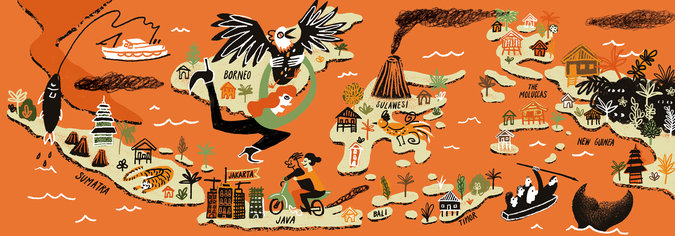

All Over the Map‘Indonesia Etc.’ by Elizabeth Pisani(Reviewed by) Joshua Kurlantzick, August 01, 2014This year, three of the world’s largest democracies are holding national elections — vast polls spread over several days and thousands of miles of territory, involving more than a billion voters. Two of these elections have attracted intense media coverage, or will. India’s national elections, which took place in May, swept out of office the long-ruling Congress Party and handed government of a rising economic and political power to the Hindu nationalist Bharatiya Janata Party. Brazil’s elections, which will be held in October, are coming on the heels of the World Cup, one of several high-profile events that have marked the country’s emergence as the second giant of the Americas. The third election, Indonesia’s presidential vote on July 9, has been mostly ignored by the international media, even though Indonesia, with a population of about 250 million, ranks as the fourth-largest country in the world, as well as the biggest economy in Southeast Asia. In “Indonesia Etc.: Exploring the Improbable Nation,” Elizabeth Pisani, a journalist, epidemiologist and on-and-off resident of Indonesia, readily acknowledges the archipelago’s feeble presence on the global stage; her friends back in London look at her quizzically when she mentions the country. Though she had flirted with Indonesia for decades, she finally tires of the world’s ignorance and chooses to take a break from work to travel the islands, offering a primer and a quick history lesson on this awakening powerhouse. Through her journey, too, she hopes to understand not only how a country as diverse and far-flung as Indonesia — at least 13,000 islands, many with their own unique cultures — has stayed together but also why, despite having had an average income similar to Malaysia’s and Singapore’s 60 years ago, it now lags badly behind. Today, some 105 million Indonesians live on less than $2 per day, though much of the country is blessed with fertile volcanic soil, rich fishing grounds, abundant natural resources and a demographic dividend, in which the country has a high ratio of working-age people to elderly. And in an era when authoritarian China is poised to become the world’s largest economy and democracy is floundering throughout the developing world, perhaps Pisani’s study of Indonesia can help answer the question of whether democracy is even compatible with the high growth needed to foster development in these emerging giants. Pisani knows that the only mental images outsiders may have of Indonesia hail from Java, the island containing nearly 60 percent of the country’s population: Wayang shadow puppets moving behind a translucent screen, luminous batik cloths and the grim-faced former dictator Suharto, who ruled between 1967 and 1998. From the time of independence in 1949, Javanese elites have monopolized politics, the military and other major institutions. Pisani’s strategy for countering Java’s dominance is to explore the other Indonesia — the forgotten parts of a forgotten country. Her journey spans a year and 26,000 miles, and she rarely takes comfortable vehicles. She jumps five-day-long ferries to the most obscure islands and cadges journeys along rutted roads on the backs of motorbikes, which leave one’s bottom bruised. Her rule for the trip, she declares, is “just say yes” to any invitation. She not only visits Indonesia’s forgotten areas; she clearly identifies with their residents, writing with passion and telling detail. On the island of Sumba, near northern Australia, she is adopted by the matriarch of one village, and moves in with the woman’s family for a time. Eventually, Pisani becomes so involved in the rituals of this Sumba village that she finds herself carrying a squawking chicken to a local mystic, who will kill it, read its entrails and tell her fortune; later, she joins a massive animal sacrifice on Sumba in honor of a recent death. Her book is loaded with such anecdotes in places that seem the opposite of cookie-cutter Southeast Asian megacities. She watches supposedly forbidden whale hunts on the island of Lembata, near East Timor. She is suddenly swept into the wedding of a friend’s brother. She stumbles into a revivalist Christian congregation in Ambon, amid the fabled Spice Islands, a congregation that seems to have been airlifted from a Texas megachurch. For someone who focuses on Indonesia, like myself, these anecdotes are tasty morsels, and rare. I had heard almost nothing, for example, about the sparsely populated Sangihe islands, between Sulawesi and the southern Philippines, where tuna fishing is the only industry. Here, Pisani says no to an offer for once, with good reason — it’s a chance to join a four-day fishing trip on the open Pacific in a rickety outrigger with only a shoddy tarpaulin for cover. Unfortunately, these anecdotes rarely cohere into more than collected stories about Indonesia’s outer provinces. Pisani introduces some broad themes that could help explain the country’s simultaneous survival and failure, but she doesn’t expand on them effectively. Indonesia, she suggests, has “welded so much difference together” through collectivism in villages and clans — collectivism that makes people more secure in their daily lives. Its citizens have generally fostered a level of cultural tolerance rare in such large nations. Yet, she suggests, it has failed to change the byzantine bureaucracy, feudal political hierarchies and entrenched corruption left by the Dutch colonizers and then the Suharto regime. At times, she also tries to introduce the nonexpert to the country’s myriad cultures but stumbles with strange analogies, calling Indonesia a “Bad Boyfriend” — it excites your senses but then angers you with its flaws. For the most part, she remains content to drift back into anecdotes rather than pull them together. Worse, though Indonesia certainly is more than just Java, the book does not really grapple with Java or several of the other populous Indonesian islands. Mostly ignoring the bigger islands means that Pisani’s picture of Indonesia, though different from those of many Indonesia specialists, is badly skewed in another way. She basically leaves out any discussion of about three-quarters of the country’s population, and makes only passing mention of Jakarta’s governor, Joko Widodo, the winner of the July presidential elections and the first post-Suharto era politician to run Indonesia. It’s as if someone tried to write a book about America but ignored 40 of the states. Javanese elitism or not, it is simply impossible to understand the staggering changes Indonesia has undergone since the end of the 1990s, including decentralization, a rapid transition to democracy and growing relationships with both China and the United States, without truly considering how decisions are made in Jakarta and other major urban centers. Instead, Pisani falls back on easy clichés about Jakarta, reform and the population itself. She deplores the rapid change and construction in the seemingly soulless capital, without seriously examining the positive aspects of all this growth, a strange omission for a public health specialist. She disdains the pork-barrel politics that come with greater direct democracy, as politicians jostle to deliver projects to their districts and sometimes skim a percentage for themselves. But this kind of patronage is necessarily curtailed by the transparency of democracy, and in the long run far healthier than the opaque and unreconstructed Suharto period. (Pisani herself acknowledges that in the latter part of Suharto’s time, “all the growth” went “into a handful of pockets,” though she still paints a fairly rosy picture of the Suharto era.) She too often portrays Indonesians as accepting their fate in life, a fatalism not apparent in this spring’s parliamentary elections, when Indonesian voters tossed out about half the incumbents. In the end, Pisani rediscovers her Bad Boyfriend idea, in a thin epilogue that again attempts to boil down what she has learned about Indonesia but soon turns into another anecdote. And another opportunity to know the unknown giant is lost. INDONESIA ETC.
|
